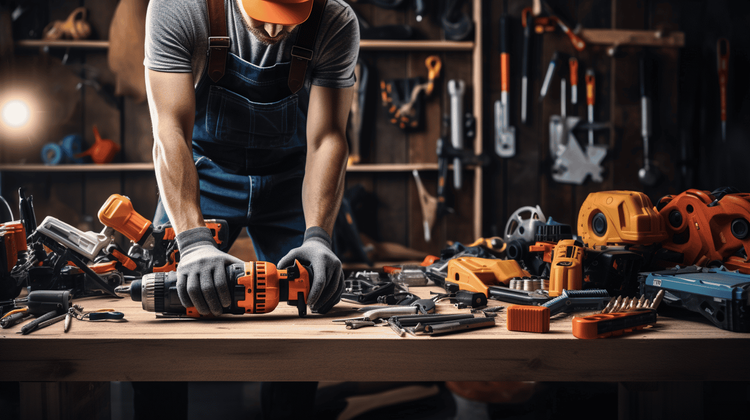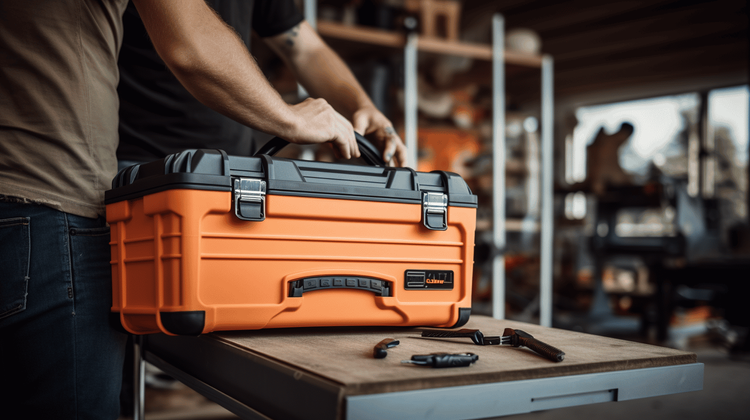Thrift-First DIY: Exploring Budget-Conscious Tool Choices

Welcome to the world of DIY (do-it-yourself), where crafting and creating turns into a delightful adventure! 🎨 But, hold up, are you worried that this newfound hobby will burn a hole in your pocket? Worry not! Here's where the "Thrift-First" approach comes into play, turning tables on traditional expensive DIY hobbies.
The age-old saying "One person's trash is another person's treasure" has never been more relevant. Today, we're diving deep into making budget-conscious tool choices and discovering the magnificent treasures hidden within thrift stores and even online marketplaces. Thrift-First DIY isn't just about penny-pinching: it's a creative and sustainable choice that opens a world of possibilities. So, are you ready to dive into the art of reusing, recycling, and revolutionizing your DIY projects? Let's get started with our guide to Thrift-First DIY and unravelling the magic of turning the old and discarded into something fresh and fantastic! 🔨 🌎 🔄
The Thrift-First Mentality
Financial independence is the rainbow's end most people are chasing. But it's no secret that the road to this coveted pot of gold can often be winding and uneven. So how do some people achieve this feat with relative ease while others are left panting and pausing? The key lies in adopting a "Thrift-First" mentality. This principle revolves around one simple idea: live below your means and prioritise savings over spending. It advocates making conscious choices that emphasize long-term stability over momentary gratification.
Understanding the Thrift-First Approach
The Thrift-First mentality is not about pinching every penny or living a deprived lifestyle. It's about understanding the difference between needs and wants and acting accordingly. Here's a quick breakdown of what this mindset entails:
- Prioritize necessities over luxuries: This means paying the bills and putting food on the table before considering the new iPhone or a designer handbag.
- Savings first, spending later: Pay yourself first. Set a fixed amount or percentage of your income that goes into your savings account before you allocate funds for other expenditures.
- Resist impulse buying: Impulse purchases can quickly derail your budget. Adopt a wait-and-see approach. If you still want the item after a few days or a week, then consider buying it.
- Be debt-sensitive: Limit your use of credit cards and strive to pay off your debts as soon as possible. Remember, the longer you stay in debt, the more interest you’ll accumulate.
Benefits of a Thrift-First Mindset
Adopting a Thrift-First mentality comes with numerous advantages. Here's how it can pave your path toward financial freedom:
- Financial independence: Prioritizing savings increases your resilience in the face of financial adversities. It creates a safety net that lets you take controlled risks and opens up opportunities for investments.
- Reduced stress: Money woes can cause immense psychological stress. Saving consistently and having a financial cushion can bring peace of mind.
- Empowerment: With your finances under control, you are in a position to make choices that align with your personal goals, not just your wallet.
- Compound interest: The sooner you start saving, the more time your money has to grow through compound interest. This can significantly enhance your wealth over time.
To recap, the Thrift-First mentality is about mindful consumption. It encourages individuals to be proactive about their financial future right from the get-go. The path isn't always easy, and it might require you to forego certain short-term pleasures. But the peace and freedom that come with being in control of your money is well worth the effort! 🚀💰 So why not consider giving this approach a try? Your future self might thank you for it. 😊
Thrift-First and DIY: A Perfect Match
The bonding of Thrift-first and DIY seems to have been written in the stars. It's a partnership akin to peanut butter and jelly, or Bert and Ernie, the type of perfect match that can turn a dull Saturday afternoon into a creative adventure. Ever thought about how much joy you can unlock by pairing thrifty buying habits with a do-it-yourself approach? Well, let's dive deep and understand why Thrift-first is an absolute game-changer for DIY enthusiasts.
Why Thrift-First Works for DIY
Thrifting, my friends, is an art form. It's the delightful act of searching through piles of hand-me-downs or rummaging through racks in second-hand stores, with the high possibility of uncovering a gem at bargain prices. If you're able to look past minor flaws and envision the potential in an item, thrift-first can serve as your magical ticket to the DIY paradise. 🎫✨
To get the most out of your thrifting, here's a list of reasons why Thrift-first works incredibly well for DIY:
- Costs: Thrifting can help keep your DIY costs down since second-hand items are often cheaper than newer ones.
- Unique Elements: When you select thrifted items, you're almost guaranteed to find unique and vintage pieces that can add personality to your design.
- Environmental Spin: Thrift-first encourages recycling, upcycling, and reducing waste, positioning your DIY projects as green, sustainable efforts that can save the planet.
- Creativity Booster: Thrift-first motivates you to reimagine and repurpose items, making it an excellent means of boosting your creativity and problem-solving skills.
Examples of Thrift-First DIY Projects
From turning an old ladder into a bookshelf to transforming vintage suitcases into quaint side tables, the possibilities are endless when it comes to Thrift-first DIY projects. Here are a few inspiring ideas to kick-start your journey:
- Furniture Makeover: Revamping an old piece of furniture such as an outdated dresser or repainting a worn-out coffee table, can give it a fresh lease on life while adding a dash of your personality. ✨
- Upcycled Clothing: If you have a knack for sewing, you could turn second-hand clothing into unique fashion statements—think cropped tops from oversized shirts or shoulder bags from jean pockets!
- DIY Home Décor: You can transform throwaway items like glass jars, old lamps, or discarded wood into decorative pieces for your home.
Don't be afraid to experiment and let your creativity run wild with Thrift-First DIY – It blends the art of saving money and embracing uniqueness with the excitement of making something original and unique! 🚀🎨
Next time you find yourself with some free time, explore your local thrift stores or second-hand markets, grab some affordable yet interesting items, and start your DIY journey. You'll be amazed at the treasures that await you!
Budget-Conscious Tool Choices
Being budget-conscious doesn't mean you need to sacrifice on the quality of your tools. What it takes is simply a shift in mindset and approach. Instead of prioritizing brand names or shiny new gadgets, we will need to go after reliable, long-lasting, and multi-functional tools that offer good value for money. Here, we delve more into this subject under the subheadings Choosing Tools on a Budget and Maintaining and Repairing Tools to Save Money.
Choosing Tools on a Budget 🛠️
The first key to successful budget shopping for tools entails understanding your needs. Knowing the tasks you intend to undertake will save you from purchasing unnecessary or over-priced tools. The following tips should help:
- Utilize product comparisons: Not all tools are created equal, and higher price does not always equate to better performance. Be sure to compare products carefully before finalizing your decision.
- Embrace multi-functionality: Tools that offer multiple functionalities can save you from buying several single-purpose ones. Consider items like a multi-tool screwdriver or a 5-in-1 painter's tool.
- Wait for sales and deals: Most hardware stores have sales regularly. By planning your purchases around these sales, you can save a significant amount.
- Buy used or refurbished: All tools don't have to be brand new. You can find excellent value in gently used or refurbished tools, as long as they're in good working condition.
Maintaining and Repairing Tools to Save Money 🔧
Buying tools is only the first part of the equation. Proper maintenance and timely repair can extend the life of your tools significantly—saving you money in the long run. Here are some effective ways to maintain and repair your tools:
- Store Properly: Tools should always be stored in a clean, dry place after use. Humidity and other elements can lead to rust or other damages.
- Regular Cleaning: After each use, wipe your tools down to remove any dirt, grease, or debris. This will prevent buildup and potential long-term damage.
- Regular check-ups: Periodically checking your tools for damages can help you catch any issues early, before they escalate or become irreparable.
- DIY Repairs: Some common tool issues, such as a broken handle or loose parts, can be easily fixed at home, saving you the cost of a full replacement.
In the quest for effective budget-conscious tool choices, remember it's all about striking a balance. Aim for good quality, affordable tools, and then ensure they are adequately maintained. By applying these ideas, you're definitely putting your best foot forward on the path to successful tool management. So, remember that thrift and value can go hand-in-hand with smart choices and good habits. 🛠️🔧🙂
Finding Tools: Thrift Stores, Online Marketplaces, and More
Finding the correct tool for a specific task can sometimes be like searching for a needle in a haystack, especially if you're on a budget. But hey, who said that the right tool should burn a hole in your pocket? This section will take you on a roller-coaster ride through some of the crunchiest spots to find affordable, yet quality tools. These would include local thrift stores, online marketplaces, and a few hidden places you might not have thought of.
Scouting Local Thrift Stores
Are you a fan of treasure hunting? 🏴☠️ If the answer is 'yes,' then thrift stores can be your paradise. Tools found at thrift stores come with stories of their own. Usually, containing a variety of tools given away, these tools may no longer serve the same purpose for the original owner but could be exactly what you’re looking for.
Here are some tips to make the most out of your thrift store hunt:
- Explore regularly: You never know when someone will drop off just the item you need.
- Be patient: It might take several visits before you find the perfect tool.
- Inspect thoroughly: Used tools can sometimes have hidden damage, so make sure to give them a careful look.
- Negotiate: Prices at thrift stores can often be negotiated. Don’t be afraid to try your hand at haggling!
Navigating Online Marketplaces
Welcome to the digital era 👩💻, where everything you need is just a click away! Though you cannot physically inspect the items, online marketplaces often provide extensive descriptions and buyer reviews to assist you in making an informed choice.
If you're new to this, worry not. Here's how you can ace your online tool shopping:
- Know your needs: What kind of tool are you looking for? How much are you willing to pay for it?
- Read the reviews: Reviews are a goldmine of information. They can tell you a lot about the tool's performance and seller's credibility.
- Check the return policy: Always check the return policy in case the tool does not meet your expectations.
- Compare prices: Numerous sellers might offer the same product. Be sure to compare prices before settling on a purchase.
Other Sources of Budget Tools
Taking a step away from the beaten path can sometimes land you in the middle of the unexplored 🕵️♀️. Garage sales, flea markets, and even some local auctions can offer an abundance of tools at discounted prices. Equipped with the experience from thrift stores and online marketplace shopping, you'll undoubtedly distinguish a great deal from a dud.
In all, finding the right tool doesn't have to be an expensive endeavor or a time-consuming task. With a little patience, a keen eye, and the right shopping strategies, you can equip your toolbox without straining your wallet. Good luck!
Getting Started with Thrift-First DIY
Starting on the road to sustainable living can feel overwhelming, especially when it comes to incorporating this mindset into our everyday lives. However, an exciting way of embracing sustainability is through Thrift-First or budget-friendly DIY (do it yourself) projects.
Unlike the popular belief that DIY projects need brand-new materials or expensive kits, a Thrift-First DIY approach is unique. The concept encourages reuse, recycling, and repurposing existing materials. Not only does it augment waste reduction, but it also makes these projects accessible for people on a tight budget.
Intrigued? Well, take a plunge into the world of Thrift-First DIY with us. We promise it will be quite a ride!
Planning Your Project on a Budget
Reducing consumerism and saving money while creating something meaningful might sound too good to be true. With careful planning, you can make this seemingly dual-purpose goal a reality by embracing the Thrift-First DIY approach.
Not sure where to start?
Voila! Here are some valuable tips to follow that could make your Thrift-First DIY planning a breeze:
- Identify your project: Think of a DIY project you'd want to embark upon. It could range from fashion, decor, gardening, or even robotics! Begin with something simple that you're passionate about.
- List of materials: Make a list of materials you need for the project. Look around your house for items that could be repurposed before buying something new. Remember, the purpose of Thrift-First DIY is to reutilize what's already around you. Garage sales and second-hand stores can be treasure troves for unusual finds!
- Plan step-by-step: Segregate the project into small actionable steps to make it less daunting. Planning also helps you stay organized and efficient.
- Set a budget: Define a budget friendly approach that aligns with your project idea and available resources. Stick to it!
Coming up with a clear blueprint not only empowers you to effectively execute your DIY project but also enriches you with unique skills and confidence.
Executing Thrift-First DIY Projects
Once you've planned your project, it's time to roll up your sleeves and start crafting. Let's look at some actionable ways to execute your Thrift-First DIY projects:
- Start small: Begin with a simple and achievable project to garner experience and confidence.
- Be patient: DIY tasks take time, especially when you're just starting out. Ensuring quality craftsmanship should be a priority over speed.
- Don't shy away from failure: It's all right to make mistakes. Every failed attempt gives you valuable insights to do better next time.
- Celebrate your victories: No matter how small, every completed project is a triumph that brings you closer to a sustainable and economical lifestyle.
Irrespective of the project size, the magic lies in the transformation. Turning an ordinary item into an extraordinary masterpiece is not only sustainable but also gratifying. So, why wait? Scribble down ideas, gather your materials, and unleash your creativity with Thrift-First DIY projects today!
Conclusion
Embracing a Thrift-First mentality in your DIY projects is not only a smart way to save money, but it also cultivates a sense of creativity and innovation in the process. By carefully choosing budget-friendly tools and learning how to maintain them, you not only add character and personalized touch to your projects but also contribute positively to the environment by promoting the culture of repair and reuse.
Consider the Bit Holder Keychain from Ultra Handy—a true testament to budget-friendly tools that support an active and hands-on lifestyle. This device conveniently organizes your screwdriver bits, making them easily available whenever you need them. It's a perfect example of the thoughtful, affordable, and functional tools you can find when you choose to prioritize thrift and sustainability in your DIY projects. So, why not bring a touch of ecosophy to your toolset and see for yourself how a Thrift-First approach can enhance your DIY experience? After all, a low budget does not mean low quality—it just means being savvier and smarter with your choices.
As you grab your tools and set off on your next DIY adventure, remember, it's all about being Ultra Handy in a budget-conscious, sustainable way. So, get creative, don't be afraid to make mistakes and remember—you're not just fixing things around the house, you're also fixing a bit of the world along the way. Check out the Ultra Handy for more helpful tips and tools on your DIY journey. Happy building!👷♂️🔨
Frequently Asked Questions
- What are some budget-friendly tool choices for DIY projects?Some budget-friendly tool choices for DIY projects include: 1. Hand tools like hammers, screwdrivers, and measuring tapes, 2. Power drills, 3. Circular saws, 4. Paint rollers and brushes, and 5. Adjustable wrenches.
- Where can I find affordable tools for DIY projects?You can find affordable tools for DIY projects at various places such as local hardware stores, online marketplaces like Amazon or eBay, second-hand stores, yard sales, and even rental services.
- Are budget-friendly tools of good quality?While budget-friendly tools may not always have the same level of quality as their expensive counterparts, many affordable options still offer decent quality and functionality. Reading product reviews and researching brands can help you make informed decisions.
- Should I prioritize buying new tools or second-hand tools?It depends on your budget and needs. Buying new tools ensures you have the latest features and warranties, but second-hand tools can be a great money-saving option. Make sure to thoroughly inspect used tools to ensure they are in good working condition.
- What are some essential tools every DIYer should have?Some essential tools every DIYer should have include: 1. Hammer, 2. Screwdriver set, 3. Tape measure, 4. Utility knife, 5. Pliers, and 6. Level. These tools can handle a wide range of DIY projects and are great for beginners.




